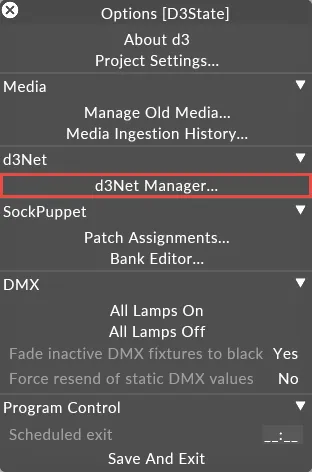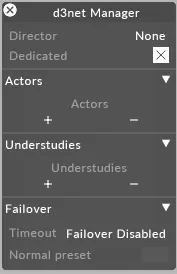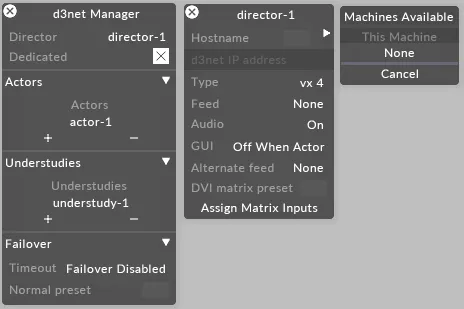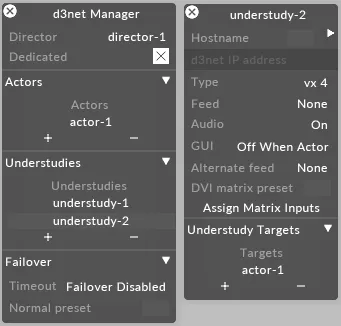d3Net Setup
d3Net Manager
Section titled “d3Net Manager”d3Net Manager is a UI widget in Designer that is used to setup a Director/Actor/Understudy network.
To open d3Net Manager:
- Open the Program Settings menu by right-clicking d3 from the d3 State editor (bar at the top of the screen).
- Left-click d3Net Manager in the d3Net tab.

d3Net Manager properties
Section titled “d3Net Manager properties”
d3Net Manager can be configured to contain all of the Disguise servers in the Director/Actor network. These machines are represented by virtual machine objects.
The Actors, Understudies and main sections of the d3Net Manager (described in greater detail below) are used to create an Actor, Understudy or Director machine.
Disguise media servers can act as any of the roles in combination with any other media servers, except for the following models which have some restrictions (outlined on their respective pages):
Designer Starter and Full (Pro) in session
Section titled “Designer Starter and Full (Pro) in session”Machines running Starter and Full versions are isolated on the network and cannot connect to each other’s sessions. As a result, Starter machines can only detect and join sessions with other Starter machines, while Full machines can only detect and connect with other Full machines.
Both Full and Starter versions of Designer can assume any machine role depending on the hardware they are running on. The table below illustrates which roles each license supports:
| Designer Starter on Non-Disguise Hardware | Designer Full (Pro) on Non-Disguise Hardware | Starter on a Disguise Media Server | Full (Pro) on a Disguise Media Server | |
|---|---|---|---|---|
| Director | ❌ | ❌ | ✔️ | ✔️ |
| Actor | ❌ | ❌ | ✔️ | ✔️ |
| Understudy | ❌ | ❌ | ✔️ | ✔️ |
| Editor | ✔️ | ✔️ | ✔️ | ✔️ |
Director
Section titled “Director”The role of the Director is to control any Actors and Understudies running within the session. Any session with multiple machines (even editors) must have a director assigned.
Dedicated vs Non-Dedicated Directors
Section titled “Dedicated vs Non-Dedicated Directors”Directors can either be Dedicated or Non-Dedicated. This changes the way the director will display content.
- A Dedicated Director will render content on all screens in the visualiser and all displays included in it’s assigned Feed Scene. This is intended for previsualisation.
- A Non-Dedicated Director will only render content on displays included in it’s assigned Feed Scene. This is an optimisation feature to maximise performance of output content.
Non-Dedicated Directors are not as performant as Actors, because they are also responsible for managing the session and rendering the GUI.
Actors
Section titled “Actors”The role of the Actor is to output video from the project timeline of the Director running in session. Each Actor will output according to its assigned Feed scene. The first output on the Actor machine, which is usually used for a GUI monitor on the Director machine, can also be used as a display output.
Understudies
Section titled “Understudies”The role of the Understudy is to take over from either the Director or Actor in the event of failure. The machines the Understudy should take over can be chosen from the Understudy targets section of the machine editor. For more information please scroll down to the section Understudy targets below.
Editors
Section titled “Editors”The role of the Editor is to make edits to a project that are then shared to the Director in real-time. Read more about setting up Editors in the Setup Editors chapter.
Failover Timeout
Section titled “Failover Timeout”The amount of time in seconds until the Understudy automatically takes over from a non-responsive machine. Note that the value 0 disables this function.
Failover Normal preset
Section titled “Failover Normal preset”The default matrix preset when all machines are functional and outputting their assigned Feed scenes. Read more about matrix presets in the Matrix & Switches subchapter.
Machine editor
Section titled “Machine editor”To open the Machine editor, right-click the machine from the Machines manager or the d3Net manager.

Host Name
Section titled “Host Name”The Hostname of the machine. This can be selected from a list of discovered machines in the d3Net network, opened by left-clicking the arrow.
The Network manager monitors the health of the Actors using their frame rates
The failover section of the Network manager monitors the health of the Director and all of its Actors using frames-per-second readouts. For more information on frame-rate readouts please scroll down to the section ‘Monitoring Actors’ below.
Each machine can be set as a certain type. Changing this value sets the capabilities of the machine for Video Input Patch and Audio Output. The value is auto-detected when the Disguise machines are connected. When machines are disconnected (for example when building your project in Disguise Designer) you can specify the type manually.
Assigns a specific Feed scene to the machine. The Feed scene contains specific outputs and can be created directly from the d3Net manager. Alternatively, Feed scenes can be created and configured before assigning them to a machine using the Output Feeds level. Please see Switching Feed scenes for more information.
Controls how audio is outputted from the machine.
offdisables all audio from the machinetimeline onlyplays audio from the Timelinevideo files onlyplays audio from video clips onlyonenables all audio.
Typically, this property is used to allow audio from video clips to play through a PA whilst suppressing the Timeline audio, which is used for reference purposes on the Director only.
Controls whether to start up with the GUI; options are off when Actor, always on and always off.
Matrix Control
Section titled “Matrix Control”This is a preset number to be automatically sent to the Matrix by the Understudy when one of the machines fails. A preset number should only be set in the Director and Actor machines. In case of a machine failure, that machine’s preset number will be sent to the matrix by the Understudy.
You can also enter the information for which input on the matrix each head on the machine is connected to for Direct Matrix routing. For more information please see the Direct Matrix routing subchapter.
If there are multiple matrix devices Designer will send the same preset to all matrix devices in the Devices manager list. For step-by-step instructions on how to create a device, please see the Creating devices subchapter.
Limitations of preset-based switching
Section titled “Limitations of preset-based switching”⚠️ Automatic preset switching is only possible when using one Understudy per failover target. If using multiple Understudies, either switch the matrix manually or use Direct Matrix routing.
Preset-based switching has implications regarding multiple understudies:
As presets are built into the matrix, presets only allow for one pre-defined route for failover. If you have multiple Understudies, a single preset can’t account for all of them simultaneously. For example, if you set up Preset 1 for Understudy A, it will only route from Understudy A’s matrix inputs.
Workflow with Understudy Groups
Section titled “Workflow with Understudy Groups”If preset based routing is required when working with multiple Understudies, one approach is to set up “Understudy groups”.
- Group your Understudies and actors: For example, “Understudy A” covers “Actor 1” and “Actor 2,” while “Understudy B” handles “Actor 3” and “Actor 4.”
- Create a unique preset for each Understudy group: These presets define the specific routing for failover, directing inputs to the correct Understudy.
- Manually activate the relevant preset when an actor fails: This triggers the pre-configured routing, letting the designated Understudy take over.
Alternate feed
Section titled “Alternate feed”Specifies the alternative Feed scene the Understudy should switch to if one of the machines fail. If set to None, the Understudy will switch itself to the standard Feed scene specified in the previous property. This is mainly used if the Understudy’s Feed scene has different output head size settings than the machine it is replacing. Please see the explanation of the Feed property above for information on how to create Feed scenes using the Output Feeds level.
Understudy targets
Section titled “Understudy targets”The machines the Understudy should take over can be chosen from the Understudy targets section of the Machine editor. However, in order to see this section:
- Create an Understudy Machine. When creating an Understudy, leave the Feed property (described below) blank. This is because it should be able to use any other Feed scene assigned to the failed machine.
- Close and reopen the Machine editor. A new section called Understudy targets will now exist at the bottom of the editor.

Understudy targets section of the Machine editor is used to add machines that the Understudy should take over.
If no machines are added to this list, then the Understudy will take over from any machine on the network.
If a Matrix device has been added to the system, the Understudy can be configured to send a preset command to the connected Matrix device.
File distribution in a Director-Actor network
Section titled “File distribution in a Director-Actor network”Once the d3Net manager has been set up correctly, copy the specific Project folder to all of the Actor and Understudy machines in the network. The video files must be distributed in such a way that every machine has all of the content files it will need to play during the show. For information on where the specific Project folder is located, please see the subchapter Projects location.
Remote control service
Section titled “Remote control service”The Disguise machines are installed with a Windows service, named d3Service. When starting Designer on the Director, the Director automatically sends out a start Disguise network command, which attempts to start the Actor(s) with the specific project. When the Actor machine starts, it looks at the d3Net manager, identifies itself in the list and switches automatically to its assigned role and Feed scene.
Monitoring Actors
Section titled “Monitoring Actors”The Director machine can monitor the health of all of its Actors. By default, the bottom right corner of the Disguise screen contains a frame-rate readout showing the number of frames Designer is outputting per second (fps).
60 fpsis the optimum frame rate and indicates a healthy machine by showing in green;<60 fpsis unhealthy and shows in red.
If you select a 50Hz output mode, a smooth 50 fps shows as green.
The Number of frames in Designer is outputting per second in this example, is a healthy 60 fps.
In Director mode, the frame readout will be accompanied by a readout for each Actor. If the Actor is not running for any reason, the readout will be in red with a - instead of a number.
In Director mode, the Director machine’s readout will be accompanied by a readout for each Actor.